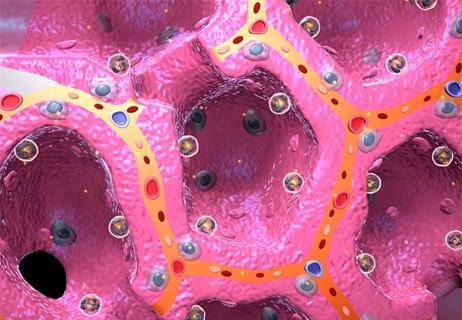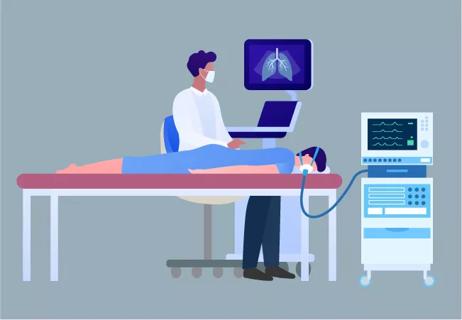A closer look at risk, clinical manifestations, treatment and prevention efforts

By Maeve Macmurdo, MD
Advertisement
Cleveland Clinic is a non-profit academic medical center. Advertising on our site helps support our mission. We do not endorse non-Cleveland Clinic products or services. Policy
Employment in kitchen construction may not raise red flags during the assessment of a patient with unexplained dyspnea. However, since late 2019, multiple cases of severe silicosis have been identified in fabricators of engineered stone kitchen countertops across the United States, Australia, Israel and Europe.1,2
Engineered stone (also known as quartz) is an alternative to traditional marble products and is increasingly utilized in home renovation and commercial construction. Made by mixing quartz crystals with a resin binding product, engineered stone may be comprised of as much as 90% silica, significantly higher than other materials such as granite or sandstone.3 As a result, cutting, grinding and polishing engineered stone products without appropriate engineering controls can result in significant release of respirable crystalline silica (RCS) – placing exposed workers at increased risk for the development of silicosis.
The risk of silicosis associated with engineered stone fabrication was first identified in 2012, after an outbreak of severe silicosis was seen in Israeli workers who had dry-cut engineered stone products.4 Investigation of 800 workers in Australia has revealed more than 160 cases of silicosis among engineered stone fabricators, with case finding still ongoing.1,5,6 Within the United States multiple clusters of silicosis have been identified among engineered stone fabricators, the majority of whom had late-stage disease at the time of diagnosis.7
While medical surveillance for silicosis is mandated for at-risk workers by the Occupational Safety and Health Administration (OSHA) 2018 final ruling on RCS, rates of screening uptake remain low, with less than 11% of employers in one state offering routine medical surveillance.8 The vast majority of engineered stone fabrication operations are small businesses, with less than 10 employees. These employers often face additional barriers to instituting medical surveillance.9 Given this, it is likely that many patients with silicosis related to engineered stone fabrication remain unrecognized.
Advertisement
Classically, silicosis presents along a spectrum of disease severity. The risk of developing silicosis is related to the duration and intensity of exposure.
“Simple” chronic silicosis is characterized by the development of small (less than 1 cm) upper lobe predominant nodules, which may be accompanied by hilar lymphadenopathy. Patients endorse progressive dyspnea and cough and may show evidence of a restrictive, obstructive or mixed deficits on pulmonary function testing. Over time these nodules may coalesce resulting in fibrotic lung disease and significant symptom burden.
Accelerated silicosis is characterized by a more rapid progression to severe fibrotic lung disease, also known as “progressive massive fibrosis.” The majority of engineered stone workers diagnosed with silicosis have presented with this accelerated form of silicosis, reflecting a pattern of high-intensity exposure to RCS.2,4,10 Due to the high levels of RCS exposure, these workers may experience progression of the disease, even after exposure cessation.11
Once silicosis has developed, options for treatment are extremely limited. Removal from further exposure to RCS may reduce the risk and speed of disease progression. Other therapies, including whole lung lavage (a procedure where large volumes of saline are flushed into the lungs and then removed) have been trialed, however, outcomes are mixed, particularly in patients whose disease already has progressed to the point of fibrosis. Transplantation is an option, and referral to a specialized transplantation center should be considered early in patients with accelerated silicosis.
Advertisement
Silicosis is preventable. Through avoidance of dry cutting, utilizing engineering controls to reduce dust release and improve ventilation and providing appropriate personal protective equipment in situations where dry cutting cannot be avoided, the amount of RCS a worker is exposed to can be significantly reduced. We are working to better understand silicosis prevention practices among employers in the engineered stone fabrication field, and to develop targeted resources to help reduce RCS exposure.
For employers who want to develop or strengthen their own silicosis prevention practices, the Cleveland Clinic Occupational Lung Disease team and Cleveland Clinic AtWork can provide expert guidance and resources to help develop medical surveillance programs and keep your workers safe.
While occupational lung diseases such as silicosis may seem like diseases of history, new occupational exposures associated with an increased risk of silicosis continue to be identified. A thorough occupational history should form part of any diagnostic evaluation for interstitial lung disease.
About the author: Dr. Macmurdo is a fellow in Cleveland Clinic’s Pulmonary & Critical Care Medicine Fellowship Program. She will join the Respiratory Institute as a staff member in July 2021 and will see patients at Cleveland Clinic’s main campus and regional hospitals. Her practice will include treating patients with occupational lung diseases.
References
Advertisement
Advertisement

Cleveland Clinic research emphasizes taking a holistic and individualized approach to care of septic shock

New developments offer providers more sophisticated options

Dynamic modeling improves the accuracy of outcome predictions for ICU patients

Lessons learned from cohorting patients and standardizing care

New tools and protocols to improve care

Cleveland Clinic pulmonologists share a framework for how to implement effective clinical protocols to standardize evaluation and management of complex acute respiratory distress syndrome

An interdisciplinary team of specialists improves outcomes with effective collaboration, communication and identifying and implementing best practices

A public health tragedy with persistent pathophysiological and therapeutic challenges